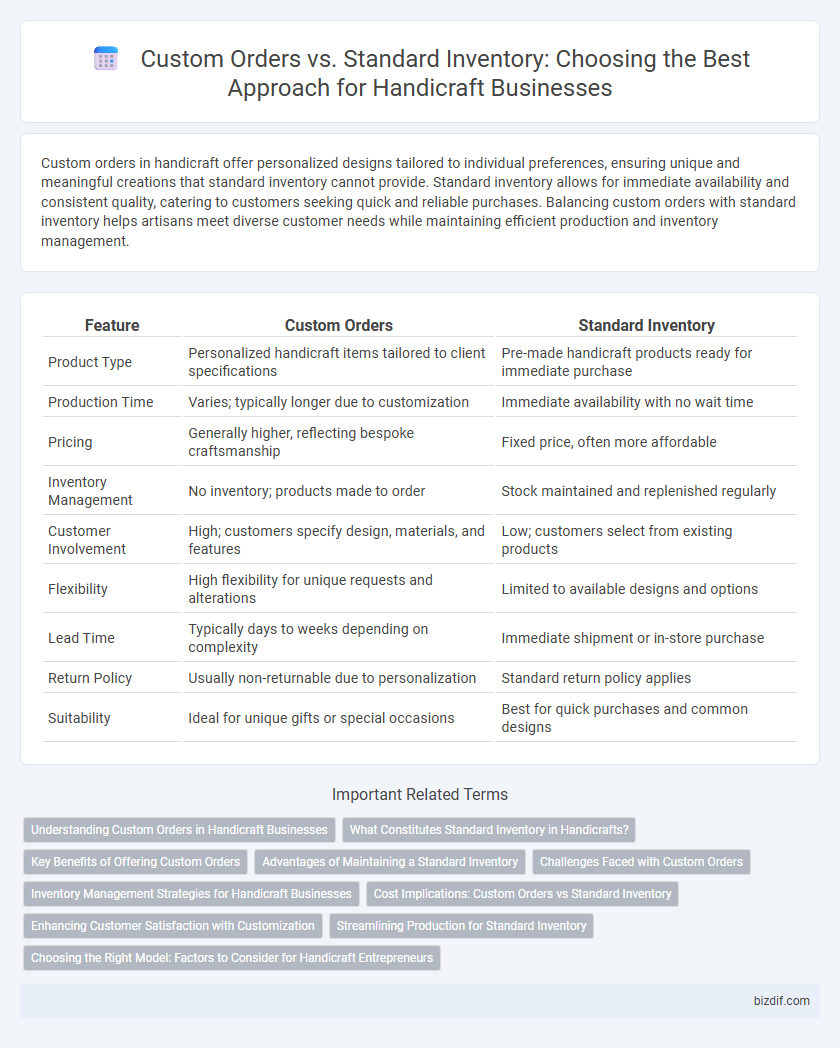Custom orders in handicraft offer personalized designs tailored to individual preferences, ensuring unique and meaningful creations that standard inventory cannot provide. Standard inventory allows for immediate availability and consistent quality, catering to customers seeking quick and reliable purchases. Balancing custom orders with standard inventory helps artisans meet diverse customer needs while maintaining efficient production and inventory management.
Table of Comparison
| Feature | Custom Orders | Standard Inventory |
|---|---|---|
| Product Type | Personalized handicraft items tailored to client specifications | Pre-made handicraft products ready for immediate purchase |
| Production Time | Varies; typically longer due to customization | Immediate availability with no wait time |
| Pricing | Generally higher, reflecting bespoke craftsmanship | Fixed price, often more affordable |
| Inventory Management | No inventory; products made to order | Stock maintained and replenished regularly |
| Customer Involvement | High; customers specify design, materials, and features | Low; customers select from existing products |
| Flexibility | High flexibility for unique requests and alterations | Limited to available designs and options |
| Lead Time | Typically days to weeks depending on complexity | Immediate shipment or in-store purchase |
| Return Policy | Usually non-returnable due to personalization | Standard return policy applies |
| Suitability | Ideal for unique gifts or special occasions | Best for quick purchases and common designs |
Understanding Custom Orders in Handicraft Businesses
Custom orders in handicraft businesses offer personalized products tailored to specific customer preferences, allowing artisans to showcase unique skills and creativity. These orders often require detailed communication, extended production time, and flexible materials, contrasting with the predictable nature of standard inventory items. Understanding the intricacies of custom orders helps craftsmen manage workflow, pricing strategies, and customer satisfaction effectively.
What Constitutes Standard Inventory in Handicrafts?
Standard inventory in handicrafts consists of pre-made items produced in consistent designs, materials, and sizes, allowing for immediate purchase without modification. These products often include popular or seasonal crafts such as woven baskets, pottery, and embroidered textiles, which are created in batches to meet general market demand. Maintaining a standardized inventory streamlines production, ensures quality consistency, and enables quicker turnover for artisan businesses.
Key Benefits of Offering Custom Orders
Custom orders in handicraft allow artisans to tailor products to individual customer preferences, enhancing personalization and satisfaction. Offering custom options can increase customer loyalty by addressing unique demands and enabling exclusive designs not found in standard inventory. This approach also helps artisans capture higher profit margins by providing bespoke creations that justify premium pricing.
Advantages of Maintaining a Standard Inventory
Maintaining a standard inventory in handicraft ensures consistent product availability, reducing lead times and satisfying customer demand promptly. It streamlines production processes, allowing artisans to focus on quality control and efficient resource management. Standard inventory also facilitates easier inventory tracking and cost predictability, enhancing overall business stability.
Challenges Faced with Custom Orders
Custom orders in handicrafts often present challenges such as unpredictable production timelines and increased material costs, which complicate inventory management and pricing strategies. Artisans must balance customer specifications with their craftsmanship limitations, leading to potential delays and increased labor intensity. Managing expectations while ensuring quality and uniqueness demands precise communication and flexibility, distinguishing custom orders from standard inventory processes.
Inventory Management Strategies for Handicraft Businesses
Efficient inventory management in handicraft businesses requires balancing custom orders with standard inventory to minimize stockouts and reduce excess materials. Employing just-in-time production for custom orders ensures timely delivery without overproducing, while maintaining a core stock of best-selling standard items supports consistent sales. Utilizing software tools for demand forecasting and inventory tracking enhances order accuracy and optimizes resource allocation.
Cost Implications: Custom Orders vs Standard Inventory
Custom orders in handicrafts typically incur higher costs due to personalized design, unique materials, and extended labor time, resulting in increased pricing compared to standard inventory. Standard inventory benefits from economies of scale, streamlined production processes, and bulk material purchases, lowering overall expenses. Consumers often face trade-offs between the exclusivity and customization of bespoke pieces versus the affordability and faster availability of ready-made items.
Enhancing Customer Satisfaction with Customization
Custom orders in handicraft provide personalized products tailored to individual preferences, significantly enhancing customer satisfaction by addressing unique needs and tastes. Standard inventory offers convenience and immediate availability, but customization fosters a deeper connection with the customer through exclusive designs and personalized details. Emphasizing custom orders allows artisans to differentiate their brand and build long-term loyalty by delivering one-of-a-kind handmade items.
Streamlining Production for Standard Inventory
Standard inventory enables streamlining production by allowing artisans to focus on consistent designs and bulk material procurement, reducing setup times and minimizing errors. Custom orders often require individual adjustments and unique materials, which increase production complexity and lead times. Emphasizing standard inventory supports efficient workflows, better resource allocation, and faster delivery without compromising quality.
Choosing the Right Model: Factors to Consider for Handicraft Entrepreneurs
Handicraft entrepreneurs must evaluate factors such as production time, material availability, and customer demand when choosing between custom orders and standard inventory. Custom orders allow for personalized creations that can command higher prices but require more time and skill, whereas standard inventory offers faster turnover and consistent quality control. Balancing flexibility with efficiency is crucial to optimize profits and maintain brand reputation in the competitive handicraft market.
Custom Orders vs Standard Inventory Infographic

 bizdif.com
bizdif.com